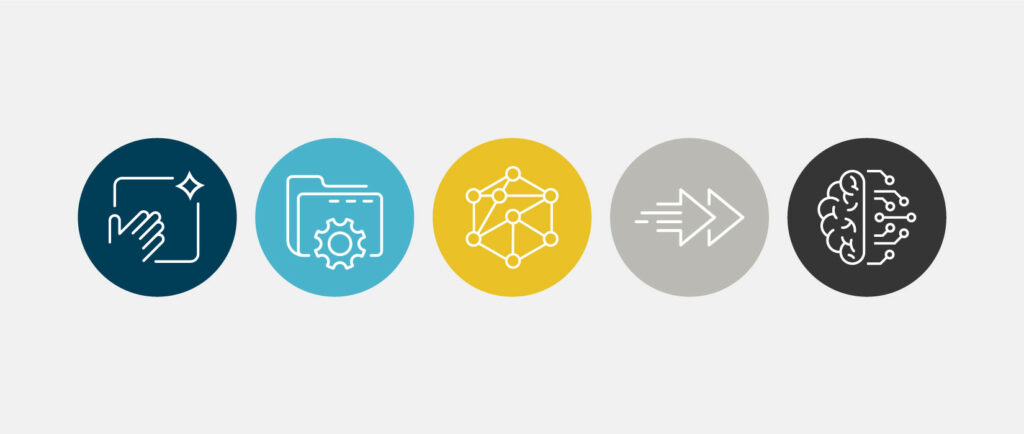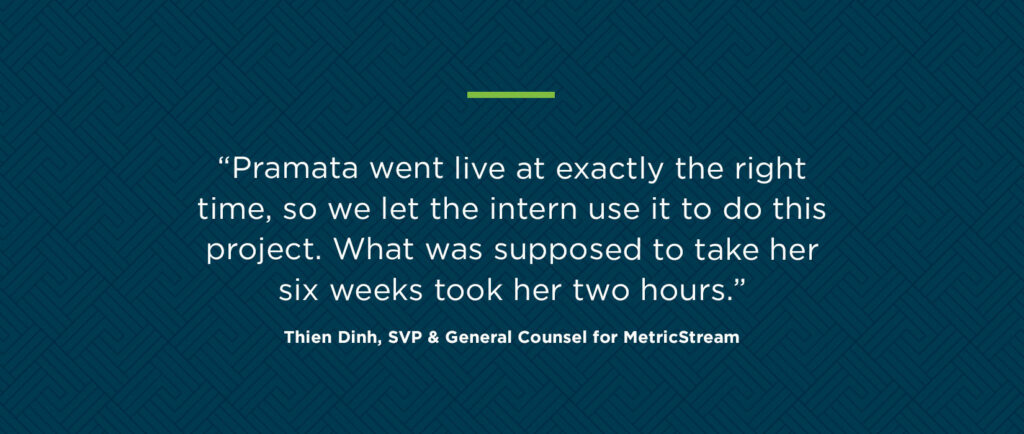Compliance monitoring can be an overwhelming challenge. Teams must continuously identify risks, perform audits and update compliance programs, all in the name of preventing liability, regulatory penalties or worse.
One important step in the process is contract compliance. For legal teams of all sizes, and particularly for small teams and solo GCs, this “task” is more like a full-time job. To ensure contracts are in compliance not only with the law but also with company standards, your team may spend hours manually sifting through contracts to identify non-compliant terms every time a law or company standard changes.
Simplifying your compliance monitoring program means streamlining your contract management processes first. And luckily, there’s technology to help you do just that. Here, we break down the challenges of manual contract compliance and how tech tools, like contract management systems, can help. You’ll learn how the right CLM can not only simplify contract management today, but dramatically reduce the time, money and effort it takes to manage your contracts’ compliance in the future.
Why manual contract compliance is risky and time-consuming for legal teams and solo GCs
Even simple contracts take hours to review. High-risk contracts may take weeks. Take a moment to consider how often regulatory requirements change, requiring new reviews. It’s easy to see just how time-consuming contract compliance can be.
Unfortunately, meticulous contract review means time spent away from more valuable work. How do you find the balance? Many lean teams can’t. They often race against the clock using review processes that are inconsistent and mistake-prone.
What’s the result of these challenges? Risk that could impact the success of your compliance monitoring program.

How embracing technology for contract compliance monitoring can help
Technology tools like contract management systems, also known as contract lifecycle management (CLM), cut risk and reduce the time it takes to review contracts.
Simplified risk prevention
A CLM can simplify risk prevention in many ways. First, it organizes all your contracts into one centralized repository. This reduces the risk that your company has contracts living in disparate locations like an employee’s hard drive, a filing cabinet or various cloud storage locations.
With built-in search tools, your team can easily find contracts using key terms in seconds. This eliminates the need to use haphazard processes to stay ahead, reducing the risk of error.
Reduced manual hours
A CLM like Pramata will use your contract playbook to determine which contracts align with your standards and which don’t—in real-time.
Instead of manually searching through contract after contract, a CLM with the right capabilities pinpoints risky contracts instantly. This means your team can spend less time searching for risk and more time mitigating it.
Improved compliance with regulations and company standards
“We’ll no longer be working with vendors in the following countries.”
“We need to identify all vendor relationships that don’t have a GDRP compliance clause in our contract.”
“How many of our customers have indemnification clauses in their contracts with us?”
There’s no doubt you’ve experienced mandates like this before within your company: often coming in the form of a “quick question” from a top executive
However, tracking down the contracts in need of review after new standards like this is nearly impossible to do manually. Fortunately, your CLM can pinpoint the specific contracts in seconds.
Auto-renewals and opportunities for price increases can also be easily discovered with the right CLM. You’ll no longer lose revenue from missed opportunities to raise prices that were built into your contracts, but never acted on, or spend unnecessary money on accidental subscription renewals. With the right technology, you can keep up with all industry changes, including regulations that impact company standards.
Enhanced standardization of contracts
Contract compliance begins the day a contract is drafted. A CLM ensures that contracts follow regulations and company standards by providing tools such as contract templates.
With these templates, you can standardize your contracts across your legal team and the entire organization. Everyone involved will have immediate access to the most up-to-date version of any given contract, reducing compliance issues from the start.

5 steps to simplify compliance monitoring with Pramata
To simplify compliance monitoring, start with your contract management processes. Pramata is a robust CLM that gives you a single source of accurate information for all your contracts across your organization. The platform does the heavy lifting to cleanse and organize your contracts, to help you ensure they’re compliant.
Pramata achieves this through a unique combination of advanced technology and a team of lawyers and contract experts working behind the scenes to ensure a high-level of contract accuracy.
1. Cleanse
Contract compliance requires you to have an organized, centralized location for all of your contracts. However, cleaning up your contracts and migrating them to a new CLM from a legacy system can be a challenge.
Pramata Cleanse transfers your contracts (from anywhere), removes duplicates and other “junk,” and converts your contracts to searchable formats—automatically. You give us your documents, and Pramata does the rest. No need to clean or organize anything beforehand.
2. Organize
With Pramata Organize, you’ll have a clear picture of all your contracts at any given time, simplifying compliance. Full-text global search enables you to find certain phrases or clauses in an instant. Powerful reporting helps you create custom reports and export results based on your needs.
3. Connect
Compliance is a team effort. With Pramata Connect, you’ll give everyone in your organization instant access to contract data. Plus, you can rest assured that everyone is using a single source for accurate, up-to-date information.
4. Accelerate
Pramata Accelerate helps you simplify and automate your contract workflow. For example, with Pramata, you can enable self-service contracting, helping your business teams to quickly generate contracts.
Concerned about consistency and compliance? Don’t be! Easily create templates and update them as changes are required to ensure that everyone in your organization is using the correct contract. Plus, it’s easy to choose which contracts require legal review, ensuring adequate, timely oversight.
5. GenAI Experiences
Supercharge efficiency by taking advantage of built-in generative AI tools. For example, with auto-draft and auto-redline capabilities, it’s easy to draft amendments for contracts that are out of compliance per standard playbooks.
With AI-assisted contract summary tools, you can get instant summaries across entire contract families for any counterparty, reducing your time spent in review.
How MetricStream leverages a digitized searchable repository to solve contract management
MetricStream, a global SaaS leader in integrated risk management (IRM) and governance, risk and compliance (GRC) solutions, struggled with their legacy CLM technology.
People in the organization were unable to manage or locate existing contracts. Plus, they had zero insight into what contracts contained without reading the entire document. Simple questions about contracts would take days to answer. They knew they needed a new solution, so they reached out to Pramata.
With Pramata, MetricStream has streamlined its contract management process. In turn, contract compliance monitoring is simplified for this organization, across thousands of contracts.

The difference Pramata can make
In one example, the legal team at MetricStream was asked by the marketing team to identify all customer contracts containing a publicity clause.
Thien Dinh, SVP & General Counsel for MetricStream, initially refused, saying it was too time-consuming. Eventually, the team decided to focus on the 20 highest-priority contracts. They hired an intern to do so, planning for her to spend six weeks on that project alone.
At the same time, Pramata had just finished implementing MetricStream’s digitized and searchable contract repository.
According to Dinh, “Pramata went live at exactly the right time, so we let the intern use it to do this project. What was supposed to take her six weeks took her two hours.” The intern was then able to spend her time performing higher-level work than manually reviewing contracts.
Just like it did for MetricStream, Pramata can cleanse, organize, connect and accelerate your entire contract management process. As a result, you can easily perform the tasks needed to monitor contract compliance, saving critical resources and reducing risk.
Schedule a demo of Pramata today
If you’re struggling with compliance monitoring, Pramata can help. To learn more about contract compliance or to see Pramata in action within your organization, schedule a demo today.



